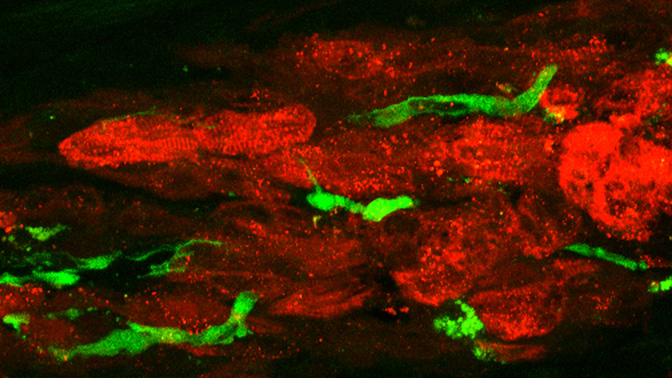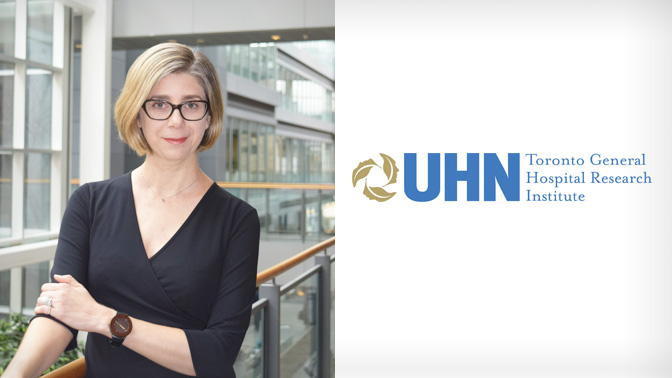Home page Description:
Scientists develop a new blood vessel system that restores function after a heart attack.
Posted On: September 23, 2020

Image Caption:
The above image, which was prepared using fluorescence microscopy, shows implanted heart cells (red) and ready-made blood vessels (green).
Scientists at Toronto General Hospital Research Institute (TGHRI) have developed a new system that could significantly advance the development of cell-based therapies for treating heart attacks, a leading cause of death in Canada.
Heart attacks occur when the blood vessels that supply blood to the heart are blocked, leading to tissue damage. These damaged regions can often develop scar tissue and lose the ability to pump blood properly.
Researchers at UHN and elsewhere have developed methods to generate functional heart cells in the lab that, in theory, could be used to repair these damaged regions.
“While the idea of using cell replacement therapy to treat heart disease has been around for over twenty years, we still do not have an approved cell therapy,” explains TGHRI Scientist Dr. Sara Vasconcelos, lead author of the work published in Science Translational Medicine.
“One key reason for the lack of effective cell therapies for heart disease is that we have yet to optimize systems to support survival of transplanted heart cells.”
To address this clinical challenge, Dr. Vasconcelos’s group has developed a lab-engineered system in which ready-made blood vessels harvested from fat tissue are implanted along with heart muscle cells.
The team found that using these blood vessels increases the survival of the transplanted heart cells more than six-fold in an experimental model of heart disease. “Our studies show that the blood vessels increase the flow of nutrients to the transplanted cells and produce factors that support cell growth, which enhances their survival,” says Dr. Vasconcelos. Transplanting the cells with the ready-made blood vessels also improves heart function in the same experimental model.
The researchers discovered that the transplanted vessels constitute the bulk of the vessels within the grafts, which is a major advancement in the field. This is in stark contrast to other known approaches for introducing blood vessels, in which most transplanted cells disappear within a few days. There are currently no other studies describing effective retention of the transplanted blood vessel cells in the heart.
The findings of the study represent a step forward in the field and could pave the way for new and effective cell-based therapies for heart disease.
This work was supported by the Canadian Institutes of Health Research, Institute of Circulatory and Respiratory Health. G Keller holds a Tier 1 Canada Research Chair in Embryonic Stem Cell Biology. RK Li holds a Tier 1 Canada Research Chair in Cardiac Regeneration.
Sun X, Wu J, Qiang B, Romagnuolo R, Gagliardi M, Keller G, Laflamme M, Li RK, Nunes S.S. Transplanted microvessels improve pluripotent stem cell-derived cardiomyocyte engraftment and cardiac function after infarction in rats. Science Translational Medicine. doi: 10.1126/scitranslmed.aax2992.

Lead author, Dr. Sara Vasconcelos, is a Scientist at the Toronto General Hospital Research Institute.




